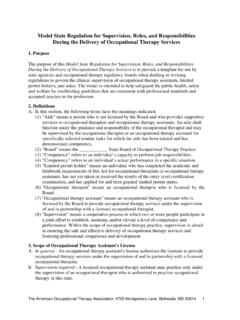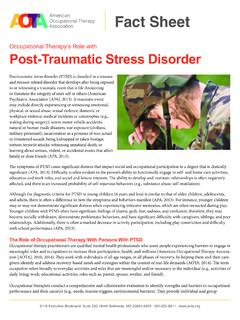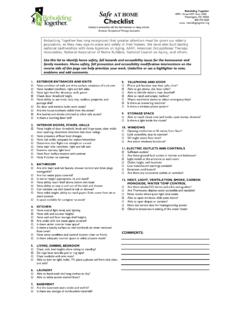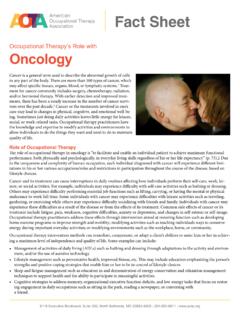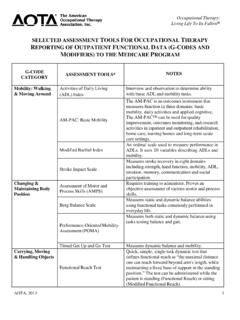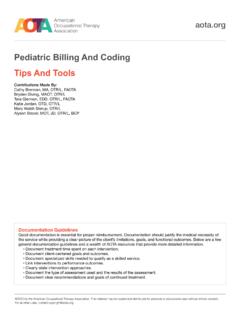Transcription of Occupational Therapy’s Role with Skilled Nursing Facilities
1 Fact Sheet Occupational therapy 's Role with Skilled Nursing Facilities Skilled Nursing Facilities (SNFs) provide medical care for variable periods of time, from relatively short to permanent. Jette, Warren, and Wirtalla (2005) determined that higher intensity Occupational therapy during rehabilitation in a SNF is associated with a shorter length of stay as well as functional improvements for a variety of conditions. The Occupational therapist, client, caregivers, and/or significant others develop collaborative goals to identify strengths and deficits and address barriers that hinder Occupational performance in roles and activities that are meaningful or necessary for that individual. In addition, Occupational therapy intervention includes preparation for discharge when appropriate, and addresses loss of functional status when discharge is not realistic.
2 The Role Of Occupational therapy in SNFs Occupational therapy practitioners focus on achieving health, well-being, and participation in life through engagement in occupation (American Occupational therapy Associa- tion, 2014, p. S4). In SNFs, they address training in self-care skills; training in the use of adaptive equipment, compensatory techniques, and environmental modifications; and behavioral and mental health issues. In addition, Occupational therapy intervention in short-term SNF rehabilitation can include: Remediating instrumental activities of daily living (IADLs) related to the patient's discharge environment, such as pre- paring a meal or managing one's home or finances Training in functional mobility, such as how to prepare a meal while using an ambulatory device Preparing the client and family for community reintegration (as appropriate for the client's discharge site)
3 With activities such as public dining or emergency response management Assessing the need for and recommending potential home modifications and safety equipment to reduce barriers and promote safe functioning upon discharge Exploring adaptations and compensatory strategies for return to volunteer or paid employment Assessing current leisure skills to determine whether modifications are needed to continue participation and/or assisting with exploring new leisure pursuits Occupational therapy for long-term-care SNF residents can also include: Teaching functional mobility, including using an ambulatory device and/or transfers to different surfaces, such as a bed, chair, toilet, or shower in order to perform self-care and personal tasks.
4 And training in wheelchair mobility and safety appropriate for the resident's level of cognition and perception Remediating or enhancing IADLs, such as ability to use the telephone or the emergency staff call system Teaching residents with cognitive and perceptual deficits in compensatory techniques to maximize abilities in areas such as attention span, orientation, sequencing, and/or memory 6116 Executive Boulevard, Suite 200, North Bethesda, MD 20852-4929 | 301-652-6611 | Teaching residents with low vision how to maximize their remaining vision and enhance safety through compensatory techniques, environmental modifications, assistive technology, and adaptive equipment Instructing residents and caregivers in techniques to improve positioning, reduce the need for restraints, and maintain skin integrity Modifying the environment and adapting tasks for safety ( , falls prevention, fatigue management).
5 Educating caregivers on ways to enhance function and preserve dignity by using the remaining abilities of adults with dementia Providing opportunities for engagement in meaningful activities despite client limitations Occupational therapy 's Role In Program Development Occupational therapy practitioners are Skilled in developing and implementing programs in SNFs that promote health and participation, remediate deficits, and address the impact of disability. Programs in this setting are based on the collabora- tive goals of the residents and staff. They may be implemented in a series of group sessions, which has the added benefit of enhancing social interaction. Some examples of those programs include.
6 Falls prevention educating patients and caregivers about hazards that may precipitate falls, and strategies to prevent them Dementia management helping the staff identify possible causes and interventions for dementia-related behaviors to enhance a client's functioning and quality of life Restraint reduction identifying positioning methods and alternatives to avoid or minimize the use of chemical and physical restraints to manage challenging behaviors Contracture management, through splinting and/or other methods to maintain range of motion and assist in prevent- ing the development or progression of deformities due to lack of movement Positioning programs to prevent disability and maintain healthy postures to enhance function Therapeutic groups to address behavioral health issues and provide opportunities for participation, to enhance func- tional skills, and to improve social interaction Pre-driving evaluation to help determine the potential to resume safe driving and recommend modifications, or to determine other community mobility options Occupational therapy practitioners play a vital role in providing client-centered, short-term.
7 And long-term rehabilitation services to individuals in SNFs. They develop and implement a variety of programs and group or individualized interven- tions to enhance the client's participation in meaningful roles and occupations of daily living to promote quality of life and client satisfaction. References American Occupational therapy Association. (2014). Occupational therapy practice framework: Domain & process (3rd ed.). American Journal of Occupa- tional therapy , 68(Suppl. 1), S1 S48. Jette, D. U., Warren, R. L., & Wirtalla, C. (2005). The relation between therapy intensity and outcomes of rehabilitation in Skilled Nursing Facilities . Archives of Physical Medicine and Rehabilitation, 86, 373 379.
8 Revised by the American Occupational therapy Association. Copyright 2015 by the American Occupational therapy Association. This material may be copied and distributed for personal or educational uses without written consent. For all other uses, contact Occupational therapy enables people of all ages live life to its fullest by helping them to promote health, make lifestyle or environmental changes, and prevent or live better with injury, illness, or disability. By looking at the whole picture a client's psychological, physical, emotional, and social make-up Occupational therapy assists people to achieve their goals, function at the highest possible level, maintain or rebuild their independence, and participate in the everyday activities of life.

